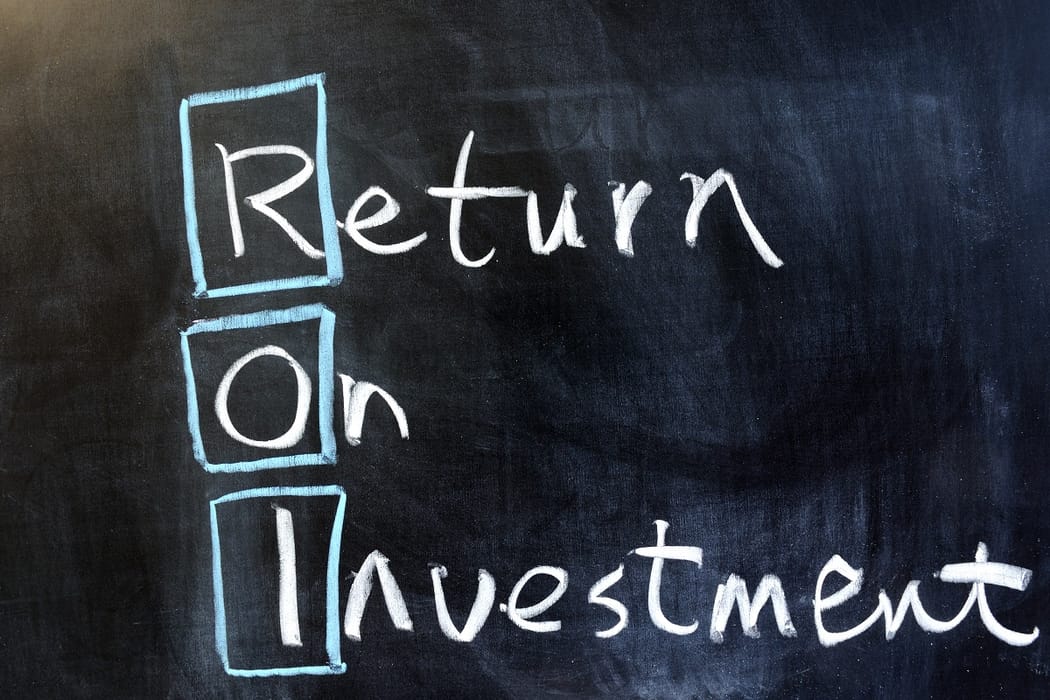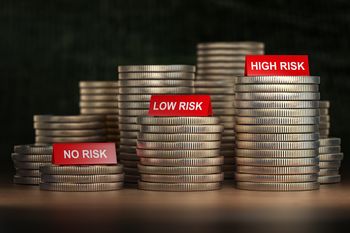When you thought of investing your money, the expected returns from investments probably impacted your decision. The rate of return on investment (ROI) is the ratio between investment and net income. ROIs are influenced by a variety of factors, such as portfolio, market, and economic conditions.
What is the return on investment (ROI)?
Return on investment or ROI can be confused with the profits of an investment. The key distinction between profits and ROI is that ROI is concerned with the money you invest and the investment returns you receive based on the business's net profit. Profit is a metric used to assess a company's performance.
Most investors will be looking for investments with the highest ROI, even though they should consider other factors, like dispersion of ROI and adjusting it with time.
Defining ROI
The ROI is a tool used to calculate the rates of return on money invested to determine whether or not to invest. Measuring ROI allows you to assess the performance of different assets in an investment portfolio. A high ROI means that your returns are higher than the cost of the investment. A lower ROI would mean the opposite.
There are several formulas[1] for calculating ROI:
- One way is to divide the profits with the investment cost (Profit / Investment cost)
- Another way is to divide the returns with the investment cost (Investment Gain / Investment cost)
All formulas show you the ROI in different contexts but the formulas are not exhaustive to these two. The general return of investment formula is to compare your returns with the costs you have undertaken and it is not only applied for investment portfolios, but it can also apply to business profits, sale of goods, time spent working compared to earnings and many more circumstances.
The importance of ROI
As the simplest form of returns measurement in percentage, ROI aids in the selection of various investment possibilities. As your investment grows, so does the importance of your ROI. You track your ROI compare the return patterns. Positive or negative ROI will help you determine whether to hold onto that investment or adjust it to the market.
Advantages and disadvantages of return on investment
ROI allows you to assess multiple assets and portfolio and choose the best one. Due to its widespread use and simplicity, many investors without extensive financial background have been able to track and improve their portfolio for better ROI and grow their overall wealth.
While ROI calculations are useful to read the profitability of investments, they are also quite limited in usage. One limitation of ROI is that it does not account for the long-term or short-term period in its calculation, nor does it account for the social, environmental, and governance in its measurement. Without these factors, decision-makers are essentially planning a future blindly where these factors can impact the ROI.
Another limitation of ROI measurements is that the calculation is too simple and allows investors to choose any variable they want (such as periods or costs) as long as they get the answer they want, even if it is misleading. For example, ROI in long-term investments cannot be correct without the Net Present Value[2].
What is ROI fluctuation?
Fluctuation can be referred to where there is a financial change or fluctuation in an investment. As your investment is supposed to be stable, so is your ROI. A little fluctuation of ROI is a given as there will be more competition, inflation and other natural economic factors. If something in your investment is changing way too often, that is regarded as fluctuation which would also change your ROI too often. Such frequent fluctuation is not a good thing for your portfolio as you may be relying on that investment for a stable income. Fluctuation at this rate would mean that you need to adjust the portfolio to minimise the volatility.
What is a good return on investment ratio?
A decent ROI for investors would vary depending on the situation, as they have their own goals and objectives. A higher ROI means that your returns are higher than the cost of the investment. What constitutes a "good" ROI will be determined by factors such as the investor's risk tolerance and the time taken for the investment to pay off. Risk-averse investors will likely accept lesser returns in exchange for accepting less risk. Similarly, if an investment does not pay off right away, it is likely that the investment will need a higher ROI to entice investors.
Historically, the S&P 500 have made an average of 10% ROI[3] over time, but it depends on the asset classes and the sector you are investing in. Healthcare, banking and finance sectors did well in the first half of 2021 in Europe[4], alonglide tech and consumer products sector. The best performing firm in 2021[5] had invested in consumer staples sector, banking and financial sector and industrials. A lot of the worst performing sectors in 2020 are also coming back strong this year, including oil & gas.
What causes ROI to fluctuate?
Now comes the main question - what causes your ROI to fluctuate? Well, a number of things, like economic factors, costs associated with your investment, and your own behaviour, may impact your ROI. If you are a new investor, it could be especially difficult to pinpoint what exactly is causing your returns to fluctuate. As a result, it would also become difficult to do something about it. Fortunately, vast sources are out there to explain the common causes of ROI fluctuations.
We will analyse and evaluate all the possible factors affecting ROI in the following:
- Economic factors
- Investment costs
- Investor behaviour
Economic factors
Economic factors consist of many complex conditions that affect your ROI. As Economic success is tied to equities and debt instruments, and other forms of investments, any change in the economic condition will likely impact those investments too. Two common economic factors play a key role that causes the ROI to fluctuate in the following:
- Financial profit: A successful economy means growing businesses, which would mean higher financial profits enabling businesses to pay their equity and debt holders handsomely. Likewise, the opposite happens when the economy slows down - businesses suffer, and so do equity and bondholders' ROIs
- Sales revenue: A growing economy also means that more people are employed, and they have the means to buy the products/services of the companies that issue the equities and debt instruments. This means more sales revenue
- Political/regulatory factors: Economic situations also include political and regulatory factors that cause the ROI to fluctuate. State budget cuts can cause higher borrowing costs for businesses, ultimately impacting their issues and interest rates. Legal bureaucracy can limit business investments in sectors which could also limit potential ROI growth for investors. Political instability will cause investors to lose confidence in both businesses and the government, negatively impacting their ROI on their issued instruments
Investment costs
Investment costs consist of fees and taxes, both of which we will explore in the following:
- Investment costs: Investment fees are the primary cause of decreased ROI due to its consistency and its ability to compound over portfolio growth. Even though they appear small in percentages, they eventually increase and cause drag on ROI. Studies have shown that fees can reduce ROI by an average of 29%[6]. Fortunately, many investors advocate for low-cost investing and recommend measuring the expense ratio to determine whether the fees are justified. The recommended rate for expense ratio[7] is between 0.5% to 0.7% for active funds and 0.2% or less for passive funds
- Tax: Understanding how your investments are taxed is critical to ROI fluctuations. The government taxes all incomes, and investment income is no exception. Of course, pensions are one investment exception unless you take it out before the retirement period. Then there is capital gains tax, which you have to pay if you sell your investments for profit. Taxes also depend on the country you live in since both income tax and capital gains tax may be lower in those countries, and in some countries, there may be no capital gains taxes at all. Some countries will give tax breaks on investments to boost your portfolio. Once you know the real rate of taxes and any tax benefits, you can decide where to allocate your investments more to maximise your ROIs
Investor behaviour
Investment behaviour is a major contributor to ROI fluctuation, and many financial incidents and countless studies have proven that. For example, investors panicked and sold everything with the S&P500 index fell by 14% in 2018[8] without looking at the bigger picture. The investors missed out on the bounceback by 11% in 2019[9]. As such, we look at some of the most common investor behaviour that causes the ROI to fluctuate in the following:
- Stock selection: Your ROI outcome depends on your ability to choose stocks that will perform well. In theory, a good ROI will have a well diversified stock portfolio and less trading to decrease investment costs. Yet most studies[10], seem to indicate the opposite in reality. Investors behave very differently in their stock selection - they trade frequently, they are influenced by media hype and have a poorly diversified portfolio in high risk category assets. Studies have also shown that more knowledge and experience does not equate to good stock selection skills. In fact, as an investor gets older, their cognitive abilities decline and as a result so does their ROI. And fund managers are no better at stock selection[11]. While their skills do result in a good ROI, the fees deplete that return
- Asset allocation: Poor asset allocation has a lot to do with poor diversification. Where diversification aims to minimise risk, poor asset allocation distributes your investment without considering the risk exposure of each asset. In fact, studies have found a diversification bias, where investors would choose more options, hoping it would maximise their profits. However, such a notion is false. This behaviour leads to a significant positive correlation between the assets where, if one asset suffers losses, the other one would too. Investors need to adjust risk exposure by allocating assets with volatility that can be counterbalanced
- Overreaction to media hype: People are known to overreact to bad news, and investment is no different. Due to fear of loss and greed, investors often lose sight of the bigger picture and end up causing financial harm to themselves. Panic selling and buying high are very common. In such cases, investors need to understand the nature of their investment to determine whether to sell or hold onto it for a larger ROI in the future
- Time mismanagement: Time mismanagement has two forms - one is not starting early with investments, and the second is thinking short-term profits only. In both cases, long-term investment is key to ROI growth because of the power of compounding and bounceback of fallen investments. It is common for investments to lose value over the short term. However, investors panic because they were subconsciously aiming for short-term growth. An example of this is the history of Black Monday, where the DOW went down by 22% in 1987[12]. The investors panicked and jumped ship only to miss out on the bounceback profit when it went up by 31.7% in 1989[13]. Had those investors thought of the long-term, they would have benefitted from such growth
Summary
The return on investment (ROI) is a technique for calculating the rates of return on money invested in order to decide whether or not to invest. A higher ROI is desirable because it indicates that your profits exceed the cost of the venture. Factors like the investor's risk tolerance and the time it takes for the investment to pay off will influence what makes a "good" ROI.
Your return on investment is meant to be stable, much like your investment. Your ROI may fluctuate depending on economic circumstances, investment costs, and your own behaviour. Frequent fluctuations are bad for your portfolio because you might be counting on that investment to provide a steady income. If the rate of fluctuation continues at this rate, you will need to alter your portfolio to reduce volatility.
The ROI can be calculated using a variety of formulas. The basic formula is to compare your profits to the expenses you've incurred. Many investors without strong financial backgrounds have been able to track and optimize their portfolio for higher ROI and total wealth growth thanks to its broad use and simplicity. While ROI estimates are important for determining the profitability of investments, their application is limited. One of ROI's limitations is that it does not account for the long-term or short-term periods in its calculation, nor does it take into consideration social, environmental, or governance factors.
ROI fluctuations are nothing to fear because they are preventable. Investors need to dive deep into their portfolios and take all the measures necessary to hedge against volatile fluctuations. Although, we should admit that not all factors can be prevented, like regulatory and political factors, and in those times, investors should do what is best for their circumstances. Otherwise, you can very much manage other conditions, especially investor behaviour.
Frequently Asked Questions
What are the main factors that cause ROI to fluctuate?
The three biggest reasons are economic conditions (such as growth, inflation, or political instability), investment costs (fees and taxes), and investor behaviour (poor diversification, panic selling, or short-term thinking).
How can investors stabilise their ROI over time?
You can reduce ROI volatility by diversifying your portfolio, keeping fees low, taking advantage of tax-efficient investment options, and sticking to a long-term strategy instead of reacting emotionally to market swings.
What is considered a good ROI for investors?
A “good” ROI depends on your goals, risk tolerance, and investment horizon. Historically, the S&P 500 has returned around 10% annually, but conservative investors may aim lower for stability, while risk-takers may target higher returns with greater volatil
List of References
- Source: accountinguide.com
- Source: investopedia.com
- Source: nerdwallet.com
- Source: hl.co.uk
- Source: hl.co.uk
- Source: esma.europa.eu
- Source: investopedia.com
- Source: cnbc.com
- Source: cnbc.com
- Source: faculty.haas.berkeley.edu
- Source: mba.tuck.dartmouth.edu
- Source: federalreservehistory.org
- Source: forbes.com






